Wood gas generator
From Wikipedia, the free encyclopedia
Click on Photo for Gasification Video...
 History
History
Origins
Gasification had been an important and common technology which was widely used to generate Town gas from coal mainly for lighting purposes during the 19th and early 20th century. When the first stationary internal combustion engines based on the Otto cycle became available in the 1870s, they began displacing steam engines as prime movers in many works requiring stationary motive power. Adoption accelerated after the Otto engine's patent expired in 1886. The potential and practical applicability of gasification to internal combustion engines were well-understood from the earliest days of their development.In 1873, Thaddeus S. C. Lowe developed and patented the water gas process by which large amounts of hydrogen gas could be generated for residential and commercial use in heating and lighting. Unlike the common coal gas, or coke gas which was used in municipal service, this gas provided a more efficient heating fuel.
During the late 19th century internal combustion engines were sometimes fueled by town gas, and during the early 20th century many stationary engines switched to using producer gas created from coke which was substantially cheaper than town gas which was based on the distillation (pyrolysis) of more expensive coal.
In about 1920 French inventor Georges Imbert created the "Imbert" downdraft generator.
During World War II gasoline was rationed and in short supply in Great Britain, United States and Germany large numbers of such generators were constructed or even improvised to convert wood and coal into fuel for vehicles. Commercial generators were in production before and after the war for use in special circumstances or in distressed economies.
Post WWII
The US Federal Emergency Management Agency (FEMA) published a book in March 1989 describing how to build a gas generator in an emergency when oil was not available.A project about the energy future of Europe was begun in 2005 in Güssing, Austria with contribution of European Union research furtherance. The project consisted of a power plant with a wood gas generator and a gas engine to convert the wood gas into 2 MW electric power and 4.5 MW heat. At the wood gas power plant are also two containers for experiments with wood gas. In one container is an experiment to convert wood gas, using the Fischer-Tropsch process, to a diesel-like fuel. By October 2005, it was possible to convert 5 kg wood into 1 litre fuel.
Design
There is a rich literature on gas-works, town-gas, gas-generation, wood-gas, and producer gas, that is now in the public domain due to its age.[1]Most successful wood gas generators in use in Europe and the United States are some variation of the earlier Imbert design. Wood gas generators often use wood, however charcoal can also be used as a fuel, it is denser and produces a cleaner gas without the tarry volatiles and excessive water content of wood.
The FEMA unit from 1989 has distinct benefits over the earlier European units such as easier refueling and construction but is less popular than the earlier Imbert design because of significant new problems, which include a lack of a fixed oxidization zone and allows the oxidization zone to creep to a larger area, causing a drop in temperature; a lower operating temperature leads to tar production and it lacks a true reduction zone further increasing this design's propensity to produce tar. Tar in the wood gas stream is considered a dirty gas and tar will gum up a motor quickly, possibly leading to stuck valves, and rings.
A new design known as the Keith gasifier improves on the FEMA unit, incorporating extensive heat recovery and eliminating the tar problem. Testing at Auburn University has shown it to be 37% more efficient than running gasoline.[2] This system set the world speed record for biomass powered vehicles[3] and has made several cross country tours.[4][5]
The United Nations produced the FOA 72 document with details about their wood gas generator design and construction, as does World Bank technical paper 296.[6][7]
Advantages
Wood gas generators have a number of advantages over use of petroleum fuels:- They can be used to run internal-combustion engines (or even gas turbines, for maximal efficiency) using wood, a renewable resource, and in the absence of petroleum or natural gas, for example, during a fuel shortage.
- They have a closed carbon cycle, contribute less to global warming, and are sustainable in nature.
- They can be relatively easily fabricated in a crisis using materials on hand.
- They are far cleaner burning than, say, a wood fire or even a gasoline-powered engine is (without emissions controls), producing little if any soot.
- When used in a stationary design, they reach their true potential, as they are feasible to use in small combined heat and power scenarios (with heat recovery from the wood gas producer, and possibly the engine/generator, for example, to heat water for hydronic heating), even in industrialized countries, even during good economic times, provided that a sufficient supply of wood is attainable. Larger-scale installations can reap even better efficiencies, and are useful for district heating as well.
Disadvantages
The disadvantages of wood gas generators are:- the large specific size
- the relatively slow starting speed; the time to heat the initially cold batch of wood to the necessary temperature level can take many minutes and in bigger plants even hours until the designed power is reached.
- a batch burning operation, that some designs feature, and that regularly interrupts the gas producing process.
- the stop operation out of a high load level is difficult (for example the stop of the engine using the gas): the residual heat still produces gas, which for a certain time leaves the gasifier either without control, or has to be used in a burner
- the primary combustible fuel-gas produced during gasification is carbon monoxide: it is an intentional fuel-product, and is subsequently burned to safe carbon dioxide in the engine (or other application) along with the other fuel-gases; however, continuous exposure to carbon-monoxide can be fatal to humans even in small to moderate concentrations.
- the humidity of the wood (usually 15 to 20%) and the water vapor created by the O- and H-atoms of the dry wood itself (about 0.4 liters of water loaded with organic substances per kg of dry wood) condenses during the gas cooling and filtering procedure and yields a liquid (see also wood tar), which needs specific waste water treatment. This treatment requires about 25 to 35 % of the created wood gas energy.
Safety consideration
When not carefully designed and used, there exists considerable potential for injury or death due to wood gas containing a large percentage of poisonous carbon monoxide (CO) gas. Wood gasifiers of proven design and thoroughly tested construction are considered safe to use outdoors, or in a partially enclosed space, for example, under a shelter open to the air on two sides; they may also be considered relatively safe to use in an extremely well ventilated (e.g. negative pressure) indoor area not connected to any indoor area used for sleeping, equipped with redundant (more than 1), completely independent, battery-powered, regularly tested carbon-monoxide detectors. However, prudence must dictate that any sort of experimental wood gasifier design or new construction be thoroughly tested outdoors, and only outdoors, with a "buddy" at all times, and with constant vigilance for any sign of headache, drowsiness, or nausea, as these are the first symptoms of carbon monoxide poisoning.In addition, mixtures of excessive quantities of air and gas should be avoided as this could lead to the deflagration (explosion) of the gas in question if a combustion source is present. Long-term storage of wood-gas, except through the use of a gasholder-type water-displacement apparatus, should not be attempted, due to the volatile elements present in the gas, which, if allowed to excessively precipitate, will condense in the storage vessel. Under no circumstances should wood-gas ever be compressed to more than 15 pounds per square inch (1.0 bar) above ambient, as this may induce condensation of volatiles, as well as lead to the likelihood of severe injury or death due to carbon monoxide or deflagration if the vessel leaks or fails.[citation
Wood Burning Stoves
Homemade wood stoves can be as simple as setting up
a windscreen and burning the wood inside it (pot set on stakes or rocks).
More complex versions are elevated off the ground to protect your fire and
ground, incorporate integrated pot stands and sometimes even have electric
fans.
There are several commercial and many more homemade
wood stoves out on the trail and the advantages are obvious.
Advantages include:
-
generally weigh a bit more than other stoves but since you don't have to carry fuel this system may be lighter than other systems for long trips
-
able to melt enormous amounts of snow without carrying huge amounts of fuel
-
cheap to make, free fuel
-
potential for unlimited hot water and even water purification
-
smoke may get rid or decrease the amount of bugs in your campsite
-
use as a heater to warm up cold bones on chilly evenings and brisk mornings
-
produce less overall pollution than other fuels (no drilling, refining, transporting, etc)
-
renewable energy source
-
a wood fire is magical
Disadvantages include:
-
weight, bulk
-
blackening of pots and everything your pot and stove touches in your pack
-
everything you hike with will smell like smoke
-
need to hunt for fuel at the end of the day or during your trek
-
dependence on availability of dry burnable wood
-
slow cook time
-
need to fiddle with the fire
-
knowledge of fire building required
-
potential to start forest fire in dry windy areas
-
may be banned in your hike area
Why is using a stove better than just starting a
fire on bare earth? Wood stoves generally reflect a great deal of the heat
back into the fire and keep it hot. It is easier to set a pot on a wood
burning stove than it is to balance it over an open fire. You will need a fraction of the wood
to cook up a meal in a stove compared to an open fire. Wood stoves also
generally protect the fire and fuel from wet and/or cold earth. They may
also be allowed where campfire aren't and can be environmentally friendly in
that they don't use up as much of the forest for fuel, produce as much smoke as
a campfire
and if purposefully built, will not even burn the ground they are on (leave no
trace).
Zip Stoves/Turbo Stoves

10oz Sierra Titanium Stove
ZZ manufacturing makes the well know Sierra Zip Ztove which is a self contained
wood stove with a battery operated fan to keep the fire going. It weights over a pound
(10 ounces for titanium version) plus the weight of the battery (AA or D cell).
There are a number of ways to improve and/or lighten the steel version of the stove (see
Links).
Fancy folks can add a solar cell to recharge batteries and help power the fan
during the day.
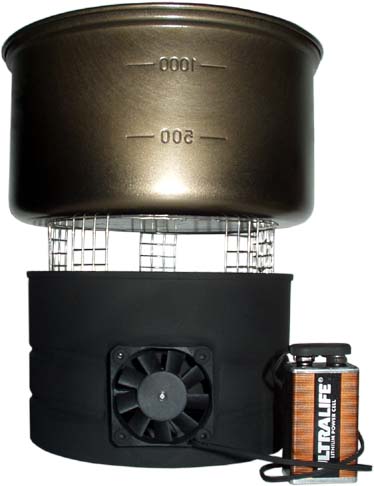
5.4oz Stove (including pot stand)
Homemade versions of this stove can be made from various sized tin cans, pots or
sheet metal (such as aluminum flashing) and an electric fan (computer fans work well) with
a power
source. Air output to the stove can be controlled by adding variable
resistors to your electrical circuit or by just moving an unattached fan further away from
the stove opening.
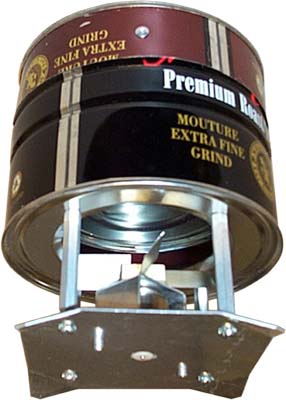
Building your stove so that it is off the ground and placing the fan
centered underneath it provides more equal distribution of forced air and
protects the ground.
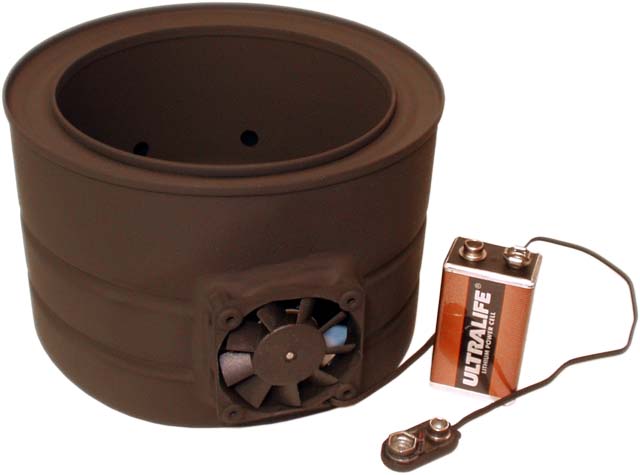
Made from 12oz Chicken and 26oz Decaf cans
Alternately, placing the fan on the side of the stove enables you to build a
less complex stove without a bottom which should be easier to build, harder to
break, and lighter.
Similar stoves include:
Kettle/Chimney/Volcano Stoves
Chimney Kettle Parts
|
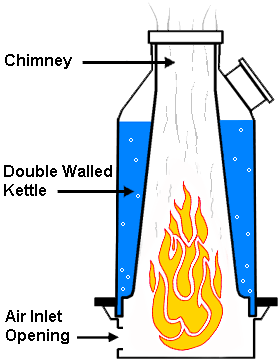
Chimney Kettle Setup
|
Chimney water heaters have been around for a long time. The Russians have
their Samovar and the Irish, Brits and Aussies all have similar kettle designs.
These incorporate a chimney that shoots up the middle of the kettle and out the top.
The kettle is set on a fire plate/bowl and when the fire gets going, hot air rises up
the chimney and out the top of the kettle, - forcing fresh air to be drawn into
air inlet opening at the bottom of the fire pit, feeding the fire and keeping the flames hot.
These are generally made of brass, tin or aluminum and depending on how they are
sealed (welded/brazed, riveted, rolled, epoxied, good/bad quality, etc),
determines if and how much they will leak.
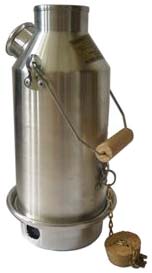
19.2oz Kelly Kettle
Homemade versions of the chimney kettle can be difficult to make requiring a
nontoxic high temperature sealer (is JB weld non-toxic when heated in drinking
water?) and/or the equipment and know-how to weld/braze your material. Aluminum
flashing works as does fitting together large aluminum cans for the outer wall with smaller ones for
the chimney. Brass is nice, but can be heavy.
Collapsible Wood Stoves
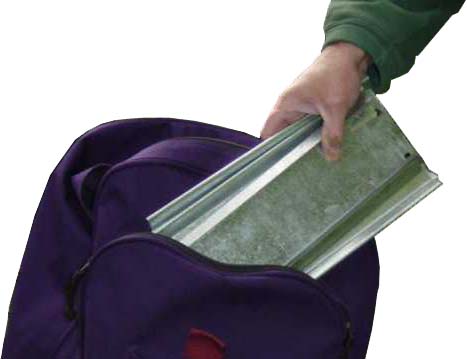
Disassembled
Fire-Spout 100
Collapsible wood burning stoves allow you to easily dismantle, flatten and pack
away what would otherwise be a very bulky setup.
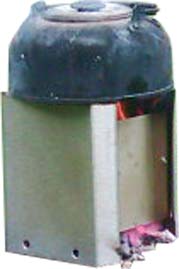
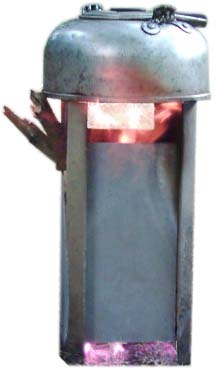
18oz Stainless
Fire-Spout-Mini and 32oz Galvanized
Fire-Spout 100
O.C.Outdoor's Fire-Spout
is one of the few truly collapsible commercial wood burning stoves on the
market.
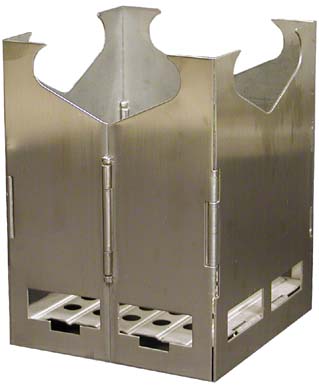
520g
Magic Stove
The Swiss
Magic Stove
is also a nice little stainless setup. Collapses to 4.5" x
5.9" x 0.4".
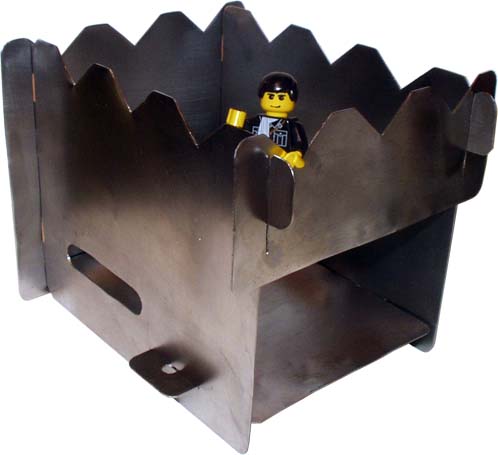
Nimblewill Nomad's Wood Burning Stove with optional front
Nimblewill Nomad's "Little Dandy" is a collapsible stove that can be
made form steel, titanium or thick aluminum sheet. It can be heavy (11.5oz
range) if you use heavy gauge steel (22GA) but flattens down nicely and is
easily packable (although it will not fit in a small pot such as the Grease
Pot unless you alter the dimensions). Galvanized steel is never
recommended as it releases heavy metals into the air when heated.
See the template page for templates.
If you are not up to making one of these yourself,
Chris Randall will be happy to
send you one from the UK for about US$25 plus shipping. According to
Chris, the Kelly Kettle fits right on to of the Nomad without modification.
Calculated weight estimates for Nimblewill Nomad's Wood Burning Stove
(including optional front)
Stainless 22GA
|
11.7oz
|
Stainless 24GA
|
9.4oz
|
Stainless 26GA
|
7oz
|
Stainless 28GA
|
5.9oz
|
Stainless 30GA
|
4.7oz
|
Steel 22GA
|
11.4oz
|
Steel 24GA
|
9.1oz
|
Steel 26GA
|
6.8oz
|
Steel 28GA
|
5.7oz
|
Steel 30GA
Side of solvent can 0.012"
|
4.6oz
|
Titanium 22GA
|
6.7oz
|
Titanium 24GA
|
5.3oz
|
Titanium 26GA
|
4.0oz
|
Titanium 28GA
Thru-Hiker's 0.016"
|
3.3oz
|
Titanium 30GA
|
2.7oz
|
Can/Tube Stoves
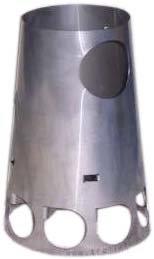
14.8 oz Trailstove
Simpler stove designs are basically ventilated steel cans
or tubes. The US$20 Trailstove comes with a hose and tube for blowing.
There are a few commercial units made of steel or titanium - and
homemade ones
can generally be fabricated from cans, pots (such as light weight and
expensive
titanium pots), or metal sheet. Aluminum flashing may work for a few
fire-ups but will burn after you get it hot enough. See our
Potstand page for information and calculators that
will help with design planning.
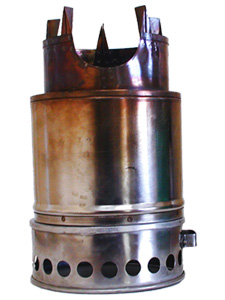
21.5oz Trekstov
More sophisticated versions have adjustable ventilation and are built sturdy (and heavy) for long term use.
The MAGH Twister Stove/ in fact is a double walled vortex stove
which uses centrifugal decomposition to mix smoke with air for a more complete
burn.
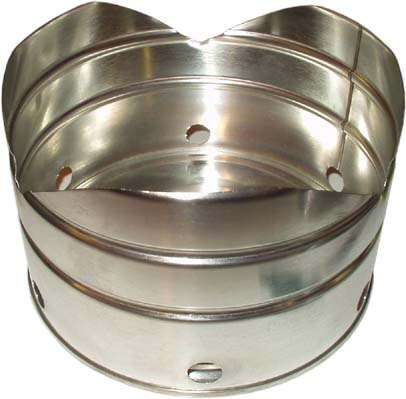
Trimmed 26oz Coffee Can (3.5oz)
Simple homemade versions can be made from trimmed down tin cans with
bottom ventilation (a church key or unibit works well for this). These
wood burners may also double and pot stands for alcohol and/or solid fuel stoves.
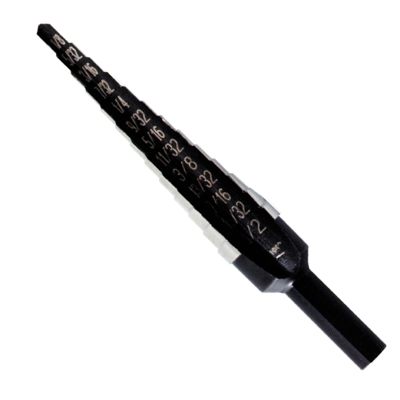
Unibit - ideal for making or enlarging holes in thin metal
A slightly lighter, rustproof and much more expensive stove may be fabricated from
a titanium pot.
WoodGas Stoves
Image modified from:
If wood is heated up and gasified, it has the potential of
burning more completely, efficiently and with little or no smoke and heavy
pollutants. These stoves tend to be a bit more complex than a tin can with
holes punched in it and therefore tend to weigh a bit more, but may make up for
extra weigh if you are packing in wood pellets or where fuel is more scarce.
For more information on wood gasification, check out
Wood-Gas Stoves for Developing Countries and
Testing and Modeling the Wood Gas Turbo Stove.
The picture above depicts a stove made from coffee cans and is
more or less self-explanatory except for the "Gas Wick." The gas wick is a
smaller diameter can suspended by wires inside the larger coffee can with its
closed bottom up. The wick become very hot and draws gas and air up along
its sides, and prevents air from going down the chimney.
It is also important to note that fuel is ignited from the top
down for the gasification process to work.
Caveats
First - If you would like to use wood as a fuel you will need to be able
to start a fire. The most important aspect of this is fire starting skill.
Learn to start a fire. Here are some basic techniques-
-
Use small dry twigs or shavings to start and add bigger stuff on top
-
Pack everything tight, add liquid fuel and light
-
A fan, tube to blow through, or sleeping pad to wave back and forth may be necessary to get the fire red and hot
Second - You will need a flame or spark, preferably waterproof
or in a waterproof container
-
Lighters
-
Matches
-
Magnesium and flint
-
Steel wool and 9V battery
-
Battery with wire or aluminum plate to heat up tinder or make a spark
-
Sparker - sparklite or other doodad
-
Magnifying glass to concentrate sunlight - can be made form ice or condom filled with water
-
Parabolic mirror - see Fire from a Can of Coke and a Chocolate Bar Part II
-
Wood Friction -
- Fire Saw (rubbing two sticks together)
- Fire Drill (Fire Bow Drill, Hand Drill, Fire Thong, Pump Drill, Fire Spindle, etc.)
- Fire Plough
-
Fire Piston - a good DIY project if you are looking for one
-
Chemical - potassium permanganate and glycerine or antifreeze or sugar
Third - You may need tinder and/or a fire starter, especially if
you are likely to have wet or damp wood.
-
Vaseline soaked cotton (real cotton) balls in film canister
-
Bottle of liquid fuel such as kerosene or alcohol
-
Knife to make wood shavings and/or "fuzz sticks" (stick with curls carved on the sides)
-
Candles (melt wax on kindling)
-
Folded up wax paper
-
Cardboard, paper or cotton soaked in wax
-
Lint from dryer
-
Fuel tabs
-
Commercial fire starter sticks
-
Fire starter paste
-
Dry pine needles, leaves, grass, bark, small twigs, etc.
-
Finished pages from novel/guide book
-
Char cloth in waterproof container or bag
-
Soap coated steel wool
-
Frayed rope (not treated with fire retardant and made from plant fibers)
-
First Aid/Hygiene kit items - cotton dressings, Vaseline impregnated dressings, toiled paper, Q-tips, tampons, etc.
-
Shaved magnesium
-
gunpowder from bullet
-
small piece of plastic explosive
Fourth - Unless you are packing in wood and packing out ash, wood
stoves are not entirely "leave no trace." Beware of uppity and/or
extremist hikers and
rangers who might frown on you burning up their wilderness. That and you
might just be part of a real eco problem - depending on where you decide to use a
wood stove.
Beyond wood, many other biofuels may be burned. You can
use agricultural waste, paper products, dried humanimal waste, coal,
charcoal, manufactured fire logs, last year's fruitcake, etc.
Firewood Quality
|
|||||||
Hard Woods
|
|||||||
Species
|
Heat
|
Weight*
|
Ease Of
Splitting
|
Ease Of Starting
|
Coaling
Qualities
|
Sparks
|
Fragrance
|
Alder
|
Medium-Low
|
2506
|
Easy
|
Fair
|
Good
|
Moderate
|
Slight
|
Apple
|
High-Medium
|
4132
|
Difficult
|
Difficult
|
Excellent
|
Few
|
Excellent
|
Ash , Black
|
Medium
|
4132
|
Easy-Moderate
|
Fair-Difficult
|
Good-Excellent
|
Few
|
Slight
|
Ash, Green
|
High
|
3590
|
Easy-Moderate
|
Fair-Difficult
|
Good-Excellent
|
Few
|
Slight
|
Ash, White
|
High
|
3,689
|
Easy-Moderate
|
Fair-Difficult
|
Good-Excellent
|
Few
|
Slight
|
Species
|
Heat
|
Weight*
|
Ease Of
Splitting
|
Ease Of Starting
|
Coaling
Qualities
|
Sparks
|
Fragrance
|
Aspen, Bigtooth
|
Low
|
2439
|
Easy
|
Easy
|
Good
|
Few
|
Slight
|
Aspen, Quaking
|
Low
|
2373
|
Easy
|
Easy
|
Good
|
Few
|
Slight
|
Basswood
|
Low
|
2174
|
Easy
|
Easy
|
Poor
|
Few
|
Good
|
Beech
|
High
|
3757
|
Difficult
|
Difficult
|
Excellent
|
Few
|
Good
|
Beech, American
|
High
|
3793
|
Difficult
|
Difficult
|
Excellent
|
Few
|
Good
|
Species
|
Heat
|
Weight*
|
Ease Of
Splitting
|
Ease Of Starting
|
Coaling
Qualities
|
Sparks
|
Fragrance
|
Beech, Blue
|
High
|
3890
|
Difficult
|
Difficult
|
Excellent
|
Few
|
Good
|
Birch, White
|
Medium
|
3179
|
Easy
|
Easy
|
Good
|
Moderate
|
Slight
|
Birch, Sweet
|
Medium
|
4065
|
Easy
|
Easy
|
Good
|
Moderate
|
Slight
|
Birch, Gray
|
Medium
|
3179
|
Easy
|
Easy
|
Good
|
Moderate
|
Slight
|
Birch, Paper
|
Medium
|
3260
|
Easy
|
Easy
|
Good
|
Moderate
|
Slight
|
Species
|
Heat
|
Weight*
|
Ease Of
Splitting
|
Ease Of Starting
|
Coaling
Qualities
|
Sparks
|
Fragrance
|
Birch, Yellow
|
High-Medium
|
3723
|
Moderate
|
Easy
|
Good
|
Moderate
|
Slight
|
Birch, Black
|
High-Medium
|
3890
|
Moderate
|
Easy
|
Good
|
Moderate
|
Slight
|
Buckeye, Horsechestnut
|
Low
|
2235
|
Moderate
|
Poor
|
Few
|
Slight
|
|
Boxelder
|
Low
|
2797
|
Easy
|
Poor
|
Many
|
Slight
|
|
Butternut (white walnut)
|
Low
|
2440
|
Easy
|
||||
Species
|
Heat
|
Weight*
|
Ease Of
Splitting
|
Ease Of Starting
|
Coaling
Qualities
|
Sparks
|
Fragrance
|
Catalpa
|
Low
|
2360
|
Difficult
|
Good
|
Few
|
Fair
|
|
Cherry, Black
|
Medium
|
2880
|
Easy
|
Difficult
|
Excellent
|
Few
|
Excellent
|
Cherry
|
Medium
|
3184
|
Easy
|
Difficult
|
Excellent
|
Few
|
Excellent
|
Chestnut
|
Low
|
2708
|
Easy
|
Many
|
Good
|
||
Coffeetree, Kentucky
|
High
|
3112
|
Moderate
|
Good
|
Few
|
Good
|
|
Species
|
Heat
|
Weight*
|
Ease Of
Splitting
|
Ease Of Starting
|
Coaling
Qualities
|
Sparks
|
Fragrance
|
Cottonwood
|
Low
|
2102
|
Easy
|
Easy
|
Good
|
Moderate
|
Slight
|
Dogwood
|
High
|
4331
|
Difficult
|
Good
|
Fair
|
Few
|
|
Elm, American
|
Medium
|
3116
|
Very Difficult
|
Fair
|
Good
|
Very Few
|
Fair
|
Elm, Rock
|
Medium
|
3860
|
Very Difficult
|
Fair
|
Good
|
Very Few
|
Fair
|
Elm, Siberian
|
Medium
|
3020
|
Very Difficult
|
Fair
|
Good
|
Very Few
|
Fair
|
Species
|
Heat
|
Weight*
|
Ease Of
Splitting
|
Ease Of Starting
|
Coaling
Qualities
|
Sparks
|
Fragrance
|
Elm, Slippery
|
Medium
|
3251
|
Very Difficult
|
Fair
|
Good
|
Very Few
|
Fair
|
Eucalyptus
|
Very High
|
4560
|
|||||
-Swamp yate
|
Difficult
|
Poor
|
Excellent
|
Few
|
Good
|
||
-Sugar gum
|
Difficult
|
Poor
|
Excellent
|
Few
|
Good
|
||
-Tasmanian blue gum
|
Fair
|
Fair
|
Good
|
Few
|
Good
|
||
Species
|
Heat
|
Weight*
|
Ease Of
Splitting
|
Ease Of Starting
|
Coaling
Qualities
|
Sparks
|
Fragrance
|
-River red gum
|
Difficult
|
Poor
|
Excellent
|
Moderate
|
Good
|
||
-SA blue gum
|
Difficult
|
Poor
|
Excellent
|
Few
|
Good
|
||
Hackberry
|
High
|
3319
|
Easy
|
Good
|
Few
|
Slight
|
|
Hazel
|
High
|
Moderate
|
Moderate
|
||||
Hawthorn
|
High
|
Moderate
|
Moderate
|
||||
Species
|
Heat
|
Weight*
|
Ease Of
Splitting
|
Ease Of Starting
|
Coaling
Qualities
|
Sparks
|
Fragrance
|
Hickory, True
|
Very High
|
4,327
|
Moderate
|
Fair-Difficult
|
Excellent
|
Moderate
|
Excellent
|
Hickory, Mockernut
|
Very High
|
4332
|
Moderate
|
Fair-Difficult
|
Excellent
|
Moderate
|
Excellent
|
Hickory, Pignut
|
Very High
|
4332
|
Moderate
|
Fair-Difficult
|
Excellent
|
Moderate
|
Excellent
|
Hickory, Shagbark
|
Very High
|
4333
|
Moderate
|
Fair-Difficult
|
Excellent
|
Moderate
|
Excellent
|
Hickory, Shellbark
|
Very High
|
4195
|
Moderate
|
Fair-Difficult
|
Excellent
|
Moderate
|
Excellent
|
Species
|
Heat
|
Weight*
|
Ease Of
Splitting
|
Ease Of Starting
|
Coaling
Qualities
|
Sparks
|
Fragrance
|
Holly, American
|
3387
|
Difficult
|
|||||
Honeylocust
|
High
|
3832
|
Easy
|
Excellent
|
Few
|
Slight
|
|
Hophornbeam, Eastern
|
4266
|
||||||
Ironwood (Hornbeam)
|
Very High
|
4267
|
Very Difficult
|
Very Difficult
|
Excellent
|
Few
|
|
Laurel, California
|
3456
|
||||||
Species
|
Heat
|
Weight*
|
Ease Of
Splitting
|
Ease Of Starting
|
Coaling
Qualities
|
Sparks
|
Fragrance
|
Locust, Black
|
Very High
|
4470
|
Very Difficult
|
Difficult
|
Excellent
|
Very Few
|
Slight
|
Madrone
|
High
|
3925
|
Difficult
|
Difficult
|
Excellent
|
Very Few
|
Slight
|
Maple, Bigleaf
|
High-Medium
|
2980
|
Moderate
|
Fair-Difficult
|
Excellent
|
Few
|
Excellent
|
Maple, Silver
|
High-Medium
|
2981
|
Moderate
|
Fair-Difficult
|
Excellent
|
Few
|
Fair
|
Maple, Black
|
High-Medium
|
3523
|
Moderate
|
Fair-Difficult
|
Excellent
|
Few
|
Excellent
|
Species
|
Heat
|
Weight*
|
Ease Of
Splitting
|
Ease Of Starting
|
Coaling
Qualities
|
Sparks
|
Fragrance
|
Maple, Soft
|
High-Medium
|
2924
|
Moderate
|
Fair-Difficult
|
Excellent
|
Few
|
Excellent
|
Maple, Red
|
High-Medium
|
3318
|
Moderate
|
Fair-Difficult
|
Excellent
|
Few
|
Excellent
|
Maple, Sugar
|
High
|
3793
|
Moderate
|
Difficult
|
Excellent
|
Few
|
Excellent
|
Mesquite
|
Very High
|
Very Difficult
|
Very Difficult
|
Excellent
|
Few
|
||
Mulberry
|
Medium
|
3712
|
Easy
|
Excellent
|
Good
|
||
Species
|
Heat
|
Weight*
|
Ease Of
Splitting
|
Ease Of Starting
|
Coaling
Qualities
|
Sparks
|
Fragrance
|
Oak, Bur
|
High
|
3928
|
Easy
|
Difficult
|
Excellent
|
Few
|
Fair
|
Oak, Red
|
High
|
3680
|
Moderate
|
Difficult
|
Excellent
|
Few
|
Fair
|
Oak, White
|
Very High
|
4200
|
Moderate
|
Difficult
|
Excellent
|
Few
|
Excellent
|
Osage Orange
|
High
|
4728
|
Moderate
|
Excellent
|
Many
|
Excellent
|
|
Pecan
|
High
|
Moderate
|
Good
|
Few
|
Good
|
||
Species
|
Heat
|
Weight*
|
Ease Of
Splitting
|
Ease Of Starting
|
Coaling
Qualities
|
Sparks
|
Fragrance
|
Persimmon
|
4332
|
Moderate
|
|||||
Pine, Lodgepole
|
Low
|
2610
|
Easy
|
Easy
|
Fair
|
Moderate
|
Good
|
Poplar, Yellow (Tuliptree)
|
Low
|
2708
|
Easy
|
Easy
|
Fair
|
Moderate
|
Bitter
|
Sweet Gum
|
Medium
|
3115
|
Difficult
|
Fair
|
Fair
|
Few
|
|
Sycamore
|
Medium
|
3115
|
Difficult
|
Very Difficult
|
Good
|
Few
|
Good
|
Species
|
Heat
|
Weight*
|
Ease Of
Splitting
|
Ease Of Starting
|
Coaling
Qualities
|
Sparks
|
Fragrance
|
Walnut
|
High-Medium
|
3454
|
Moderate
|
Fair
|
Good
|
Few
|
Fair
|
Willow
|
Low
|
2438
|
Easy
|
Fair
|
Poor
|
Moderate
|
Slight
|
Soft Woods
|
|||||||
Species
|
Heat
|
Weight*
|
Ease Of
Splitting
|
Ease Of Starting
|
Coaling
Qualities
|
Sparks
|
Fragrance
|
Cedar, White
|
Medium-Low
|
2100
|
Easy
|
Easy
|
Poor
|
Moderate
|
Excellent
|
Cedar, Eastern
|
Medium-Low
|
2981
|
Easy
|
Easy
|
Poor
|
Many
|
Excellent
|
Cedar, W. Red
|
Medium-Low
|
2100
|
Easy
|
Easy
|
Poor
|
Many
|
Excellent
|
Cypress
|
Medium
|
2844
|
Easy
|
Moderate
|
Few
|
||
Fir, Douglas
|
Medium
|
3049
|
Easy
|
Easy
|
Fair
|
Moderate
|
Slight
|
Species
|
Heat
|
Weight*
|
Ease Of
Splitting
|
Ease Of Starting
|
Coaling
Qualities
|
Sparks
|
Fragrance
|
Fir, Balsam
|
Low
|
2236
|
Easy
|
Easy
|
Fair
|
Moderate
|
Slight
|
Fir, Grand
|
Low
|
2371
|
Easy
|
Easy
|
Fair
|
Moderate
|
Slight
|
Fir, White
|
Low
|
2104
|
Easy
|
Easy
|
Fair
|
Moderate
|
Slight
|
Hemlock, Eastern
|
Medium-Low
|
2573
|
Easy
|
Easy
|
Poor
|
Many
|
Good
|
Hemlock, Western
|
Medium-Low
|
2847
|
Easy
|
Easy
|
Poor
|
Many
|
Good
|
Species
|
Heat
|
Weight*
|
Ease Of
Splitting
|
Ease Of Starting
|
Coaling
Qualities
|
Sparks
|
Fragrance
|
Juniper
|
Medium
|
3150
|
Medium
|
Poor
|
Many
|
Excellent
|
|
Larch, Western (Tamarack)
|
High-Medium
|
3318
|
Easy-Moderate
|
Easy-Fair
|
Fair
|
Many
|
Slight
|
Pine, Lodgepole
|
Low
|
2576
|
Easy
|
Easy
|
Fair
|
Moderate
|
Good
|
Pine, Ponderosa
|
Medium-Low
|
2573
|
Easy
|
Easy
|
Fair
|
Moderate
|
Good
|
Pine, E&W White
|
Medium-Low
|
2303
|
Easy
|
Easy
|
Fair
|
Moderate
|
Good
|
Species
|
Heat
|
Weight*
|
Ease Of
Splitting
|
Ease Of Starting
|
Coaling
Qualities
|
Sparks
|
Fragrance
|
Pine, Sugar
|
Low
|
2302
|
Easy
|
Easy
|
Fair
|
Moderate
|
Good
|
Pine, Yellow
|
High-Medium
|
2610
|
Easy
|
Easy
|
Fair
|
Moderate
|
Good
|
Pinon
|
High
|
3000
|
Easy
|
Many
|
|||
Redwood, Old Growth
|
Medium
|
2573
|
Easy
|
Easy-Fair
|
Poor
|
Many
|
Slight
|
Redwood, Second Growth
|
Medium
|
2302
|
Easy
|
Easy-Fair
|
Poor
|
Many
|
Slight
|
Species
|
Heat
|
Weight*
|
Ease Of
Splitting
|
Ease Of Starting
|
Coaling
Qualities
|
Sparks
|
Fragrance
|
Spruce, Black
|
Low
|
2575
|
Easy
|
Easy
|
Poor
|
Few
|
Slight
|
Spruce, Engeiman
|
Low
|
2234
|
Easy
|
Easy
|
Poor
|
Few
|
Slight
|
Spruce, Norway
|
Low
|
2240
|
Moderate
|
Easy
|
Poor
|
Many
|
Slight
|
Spruce, Sitka
|
Low
|
2506
|
Easy
|
Poor
|
Slight
|
||
Yew
|
High
|
Difficult
|
Difficult
|
Good
|
|||
*Weight - pound /cord - seasoned
wood.
Cord - stack 4' x 4' x 8'
feet high (~85 ft3 with air space removed)
Face cords - 4' x 8' x <4' (usually
about 16" deep)
|
|||||||
Alder: Poor heat output and short lasting. A
low quality firewood. Produces nice charcoal that burn steady and is
useful for homemade gunpowder.
Apple: Great fuel that bums slow and steady when dry,
with little flame, sparking or spitting. It has a pleasing scent. It is
easier to cut green. Great for cooking.
Ash: Considered one of the burning wood with steady flame and
good heat
output. It
will bum when green, but not as well as when dry. Easily to saw and split.
Beech: Similar to ash, but only burns
fair when green. If it has a fault, it may shoot embers out a long ways.
It is easy to chop.
Birch: This has good heat output but burns quickly. The smell
is also pleasant. It will burn unseasoned. Can cause gum deposits in
chimney if used a lot. Rolled up pitch from bark makes a good firestarter
and can be peeled from trees without damaging them.
Blackthorn: Burns slowly, with lots of heat and little
smoke.
Cedar: This is a great wood that puts out a lot of
lasting of
heat. It produces a small flame, a nice scent, and lots of crackle and
pop. Great splitting wood. Best when dry but small pieces can be
burned unseasoned. Good for cooking.
Cherry: A slow burning wood with good heat output.
Has a nice sent. Should be seasoned well. Slow to start.
Chestnut: A mediocre fuel that produces a small
flame and weak heat output. It also shoots out ambers.
Douglas Fir: A poor fuel that produces little flame
or heat.
Elder: A mediocre fuel that burns quickly
without much heat output and tends to have thick acrid smoke. The Hag
Goddess is know to reside in the Elder tree and burning it invites death.
Probably best avoided.
Elm: A variable fuel (Dutch elm disease) with a
high water content (140%) that may smoke
violently and should be
dried for two years for best results. You may need faster burning wood to
get elm going. A large log set on the fire before
bed will burn till morn. Splitting can be difficult and should be done
early on.
Eucalyptus: A fast burning wood with a pleasant
smell and no spitting. It is full of sap and oils when fresh and can start
a chimney fire if burned unseasoned. The stringy wood fiber may be hard to
split and one option is to slice it into rings and allow to season and self
split. The gum from the tree produces a fresh medicinal smell on burned
which may not be the best for cooking with.
Hawthorn: Good firewood. Burns hot and slow.
Hazel: An excellent fast burning fuel but tends to
burn up a bit faster than most other hard woods. Allow
to season.
Holly: A good firewood that will burn when green, but best
if dried a year. It is fast burning with a bright flame but little heat.
Hornbeam: Burns almost as good as beech with a hot
slow burning fire.
Horse Chestnut: A low quality firewood with a good flame and heating power
but spits a lot.
Laburnum: Completely
poisonous tree with
acrid smoke that taints food and is best never used.
Larch: Crackly, scented, and fairly good for heat.
It needs to be seasoned well and forms an oily soot in chimneys.
Laurel: Produces a brilliant flame.
Lime: A poor quality fuel with dull flame.
Good for carving
Maple: A good firewood.
Oak: Oak has a sparse flame and the smoke is acrid
if not seasoned for two years. Dry old oak is excellent for heat, burning
slowly and steadily until whole log collapses into cigar-like ash.
Pear: Burns with good heat, good scent and no
spitting. Needs to be seasoned well.
Pine: Bums with a splendid flame, but apt to spit.
Needs to be seasoned well and is another oily soot in chimney wood. Smells
great and its resinous wood makes great kindling.
Plane: Burns pleasantly, but is apt to throw sparks
if very dry.
Plum: Wood provides good heat with a nice aromatic sent.
Poplar: A terrible fuel that doesn't burn well and
produces a black choking smoke even when seasoned.
Rowan: A good firewood that burns hot and slow.
Rhododendron: Old thick and tough stems
burn well.
Robinia (Acacia): Burns slowly, with good heat, but with
acrid smoke.
Spruce: A poor firewood that burns too quickly and with too many sparks.
Sycamore: Burns with a good flame, with moderate heat.
Useless green.
Sweet Chestnut: Burns when seasoned but tends to
spits continuously and excessively.
Thorn: One of the best firewood. Burns slowly,
with great heat and little smoke.
Walnut: Low to good value to burning. It a
nice aromatic scent.
Wellingtonia: Poor for use as a firewood.
Willow: A poor fire wood that must be dry to use.
Even when seasoned, it burns
slowly, with little flame. Apt to spark.
Yew: This burns slowly, with fierce
heat. The scent is pleasant. Another carving favorite. Note that
every part of this plant, except for the fruit contains poisonous taxines.
Death to livestock after ingestion of this plant is well documented and here are
reported cases of suicides from ingestion of leaves. Sawdust is dangerous
if ingested or inhaled. The Romans reported death after ingestion of wine
stored in Yew vessels, yet Yew cups, bowls and plates are still very popular -
not that this makes them any less poisonous. Taxines are carried in smoke
and the safety of using this wood for cooking or heat is questionable.


No comments:
Post a Comment
Do To the enormous amounts of spam I will no longer take the time to moderate Anyone posting under anonymous... Sorry for the inconvenience but my email is blasted everyday with 40 to 50 anonymous posts that are junk mail. I just don't have the time to read each one before deleting.